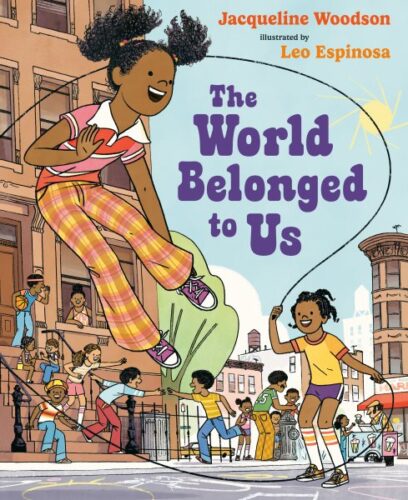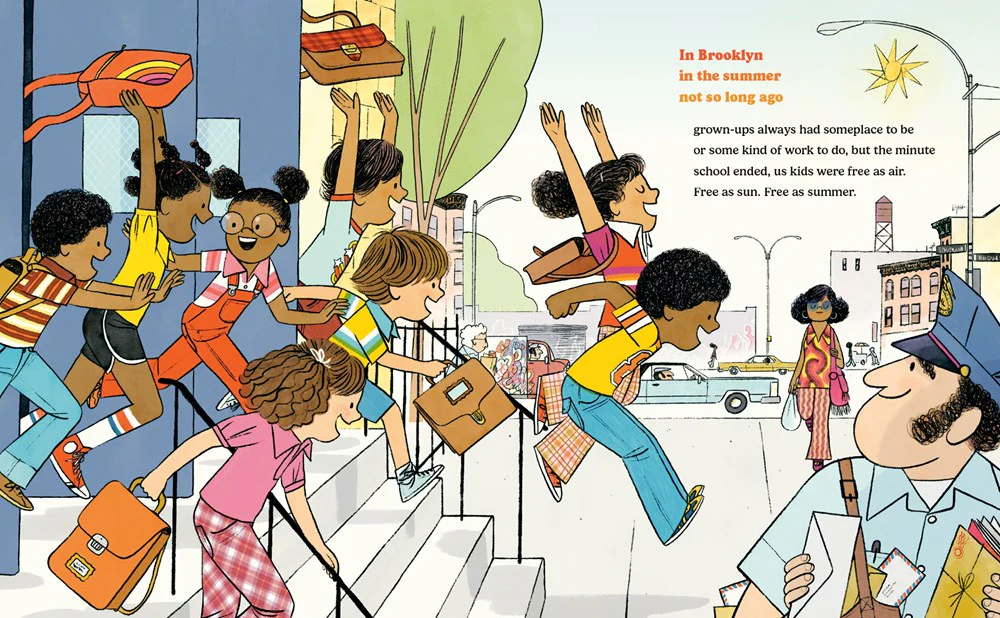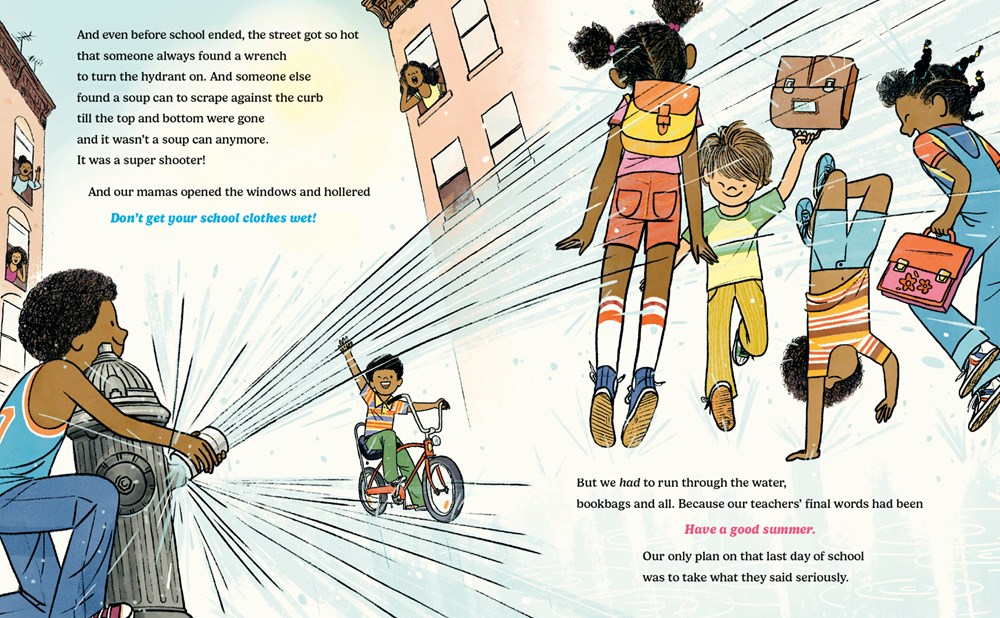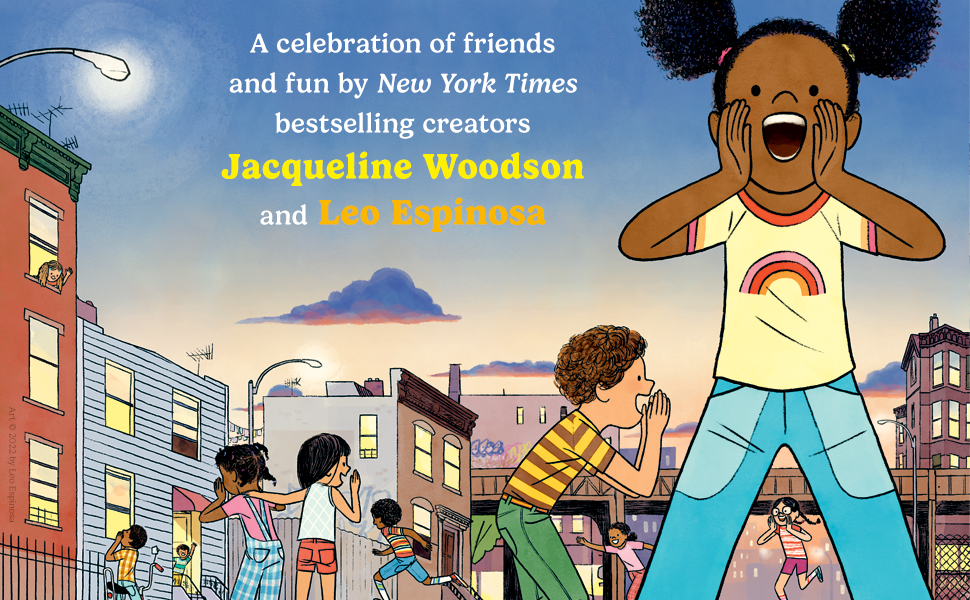Review of the Day: The World Belonged to Us by Jacqueline Woodson, ill. Leo Espinosa

The World Belonged to Us
By Jacqueline Woodson
Illustrated by Leo Espinosa
Nancy Paulsen Books (an imprint of Penguin Random House)
$18.99
ISBN: 9780399545498
On shelves now
The parent that grew up reading books with their own parents as a child is the parent that will fall back on those same books when they have children of their own. Usually. I’m dealing in vast generalizations here, but I don’t think I’m that far off. As a children’s librarian I would watch countless new parents come in the doors of the library with their tiny offspring and beeline for the picture books that they remembered as a kid OR that have some kind of name recognition in American society. The trained children’s librarian can, however, lure those parents with the enticements of newly published books if they know how to go about it. So here’s an interesting idea: What if you enticed such guardians with books that kind of harkened back to their childhoods? Or, if not their actual childhoods, then maybe the childhoods they saw in books and TV shows when THEY were kids. It’s a curious notion, but an interesting one. I’m imagining picture books set in the 80s and 90s, could be interesting. Jackie Woodson, however, has created The World Belonged to Us, which is this unapologetic paean to a wild, unbridled childhood in the 70s. And let me tell you, in a world of helicopter parenting and consistent supervision, there’s a certain kind of child that’s going to take one look at this and put it right up there with the wildest imaginings of fantasy and lore. As is right.
“In Brooklyn in the summer not so long ago…” Children burst straight out of school on the last day, “free as air. Free as sun. Free as summer.” As we watch they leap through the blast of the fire hydrant’s spray. Their hair springs into its natural curls. They play on skully boards, jump rope, turn cardboard boxes into forts, and call up to their parents for money for ice cream. And when the day starts to close and dinner is waiting, they make plans for the next day and maybe even the day after that. Excited for the future, whatever that may be.
ADVERTISEMENT
ADVERTISEMENT

I was born in 1978. As such, I was probably one of the last generations to have a free range childhood like the kind pictured here. The other day I had to explain to my 8-year-old the various reasons why I couldn’t just let him wander off around town like kids used to. Let me be clear that there are plenty of 8-year-olds still out there, playing in the streets like in the old days. But their numbers are way way down, and the likelihood of some supposedly well-meaning person calling the cops on their parents is much higher than I’d like to think about. I wish I could just give my kid the sheer freedom you feel in The World Belonged to Us. Jackie taps so perfectly into that feeling a kid could have just out there, outside of their house, playing with their friends. In this story the only adults are glimpses of parents, the guys selling flavored ices or ice cream, vague historical figures, and maybe the occasional indulgent mailman. For the most part, this is all about the kids.
By this point we have high expectations with each and every Jacqueline Woodson title that falls into our lap. We expect great things. Kind of sucks for her, though. I mean, imagine if every book you wrote was supposed to be some Great Work of Literature. Where’s the fun in that? That’s why it’s so nice to see her cut loose with a book like The World Belonged to Us. Not that she’s phoning it in or anything. No, at this point I think Ms. Woodson has passed beyond the point where she can just dash something off and call it a day. Even for all its vivacity and fun, this book still has jolts of thoughtfulness and meaning crammed in there. One of my favorite moments in the book occurs when a kid scrapes her knee and an older kid is there to tell everyone about his own injuries. “And if someone said Boys don’t cry, some big boy always said Oh yeah? and had a story about the time he cried and cried until our eyes grew wide. Our hurt knees forgotten.” You see how casually she worked that in there. She crunches in all these mini stories within the bigger, overarching one and the overall affect is that you’re there, living this life, seeing these things. All this culminates in the ending of the book. You know, the older I get, the more I come to appreciate picture books that know how to stick the landing. This book contains one of Jackie’s more elegant cappers. She actually manages to leave you feeling not just wistful but reflective. She ties this moment in her personal history to a meaning that subsequently stayed with her throughout the rest of her life. How’d she do that?

And then there is Leo Espinosa. I would like to sit him down and talk to him about the research that he did for this book. And if he doesn’t tell me that he consumed great quantities of early Sesame Street I will be very much confused. To my Generation X eyeballs, this had the Children’s Television Workshop in its blood. Interestingly, Mr. Espinosa is from Bogota, Colombia. At the risk of stating the obvious, he did not grow up in Brooklyn. Now there is a longstanding history of great illustrators going out of their way to illustrate NYC in the 60s and 70s without ever having lived there themselves. The most immediate example of this is The Boy Who Didn’t Believe in Spring (which pairs beautifully with this book) by Lucille Clifton and illustrated by, of all people, Brinton Turkle (a guy better known for writing early American picture books about Quakers with names like “Obadiah”). Or think about when Langston Hughes or James Baldwin wrote books for kids. Their illustrators weren’t NYC natives at all. Leo Espinosa is very much in their same boat, and whatever research he did, it’s paid off.
My first instinct upon seeing this cover was to briefly wonder if I hadn’t accidentally picked up a book from 1975. Espinosa has given us a child’s eye view of the paradise of a NYC summer. Naysayers will nay and say that it’s an awfully clean Brooklyn street we’re looking at here. I think would probably be missing the point. This whole book is a memory. Do you remember playing with your friends as a kid? The focus of these pages is the laughter and the movement. The games! The stories! And then there are the clothes. In between the sheer movement of the characters on these pages the clothes are what really stick with you. Those knee socks and plaid pants and striped shirts. Sweatbands. And those colors! Shades that Ernie and Bert themselves would envy. This book must have been fun to do. It must have! Think of all the cars he got to include. I’ll tell you truly that I got so into the art of this book that I had this overwhelming desire for it to change seasons. I suddenly and desperately wanted to see this neighborhood in the fall. I wanted to see it in the rain. I wanted so much more of it than just summertime. Don’t be too surprised if you find you have the same reaction.

Jackie Woodson must have been just totally floored when she saw Mr. Espinosa’s art. I look at it and it’s like I’m thrust bodily into a past that’s adjacent to the one I lived, but utterly different. But as a kid I watched Fat Albert, Sesame Street, The Electric Company, and more. I got glimpses into childhoods that were pale echoes of the one featured here. This all begs the obvious question (which has inexplicably been left to the bottom of this review) of whether or not kids will enjoy this book. I am reminded of something that happened when my eldest daughter was four or five. I had been reading her A Time to Keep by Tasha Tudor, which had been a favorite of mine as a kid. The book, much like this one, shows kids merrily running around having loads of fun with minimal parental supervision. At some point, though, my daughter turned to me exasperated. “Why are you reading me a book full of fun stuff I’ll never do?” I didn’t really have an answer for that at the time, but since then I’ve decided that the response I should have given was that when you read a book that Tudor’s or like The World Belonged to Us, that very act makes it a part of your own history. Kids that read this book today will be able to carry with them the memory of being a part of these wild unencumbered street kids, vicariously. And memory, being the slippery and highly influential thing that it is, can be coaxed into equating what you read with what you experience. The children that read this book get to live Jackie’s childhood. Thanks in large part to Mr. Espinosa’s illustrations, they are plunged headlong into the energy and sheer thrill of the past. It’s a little time machine mixed with a heavy dose of the best kind of nostalgia, and you wouldn’t have it any other way. An explosion on the page. Sublime.
On shelves now.
Source: Final copy sent from publisher for review.
Filed under: Best Books, Best Books of 2022, Reviews, Reviews 2022
About Betsy Bird
Betsy Bird is currently the Collection Development Manager of the Evanston Public Library system and a former Materials Specialist for New York Public Library. She has served on Newbery, written for Horn Book, and has done other lovely little things that she'd love to tell you about but that she's sure you'd find more interesting to hear of in person. Her opinions are her own and do not reflect those of EPL, SLJ, or any of the other acronyms you might be able to name. Follow her on Twitter: @fuseeight.
ADVERTISEMENT
ADVERTISEMENT
SLJ Blog Network
Happy Poem in Your Pocket Day!
More Geronimo Stilton Graphic Novels Coming from Papercutz | News
Parsing Religion in Public Schools
Environmental Mystery for Middle Grade Readers, a guest post by Rae Chalmers
ADVERTISEMENT








Wow! What a beautiful, amazing book! Such a tribute to memories of childhood (I didn’t grow up in Brooklyn, but we did wander the streets of our neighborhood and play unsupervised!) and I love this artwork! thanks for a fun post… definitely getting this one.
Betsy, I’ve been pondering in my mind since Friday how I wanted to reply to this review and post. Jackie Woodson is my favorite female writer. I own and treasure all of her books. I came into the world 32 years ahead of you . . . just five weeks after the advent of the Baby Boomer generation. You may not know at that time Dr. Spock ruled the nation as the most revered expert on parenting. I learned (thanks to Anita Silvey and later a copy of Spock’s book copyright 1946) that in the late 40s and 50s he recommended caretakers NOT read books to children . . . a task better left for teachers. Sadly, my family largely followed this advice.
I greatly relate to your reflections of childhood when kids were turned out of their homes right after breakfast, joined other youngsters in the neighborhood and spent most summer days unsupervised, free, and expected to problem-solve, creatively design their own projects and games, negotiate differences of opinions, etc. A child might return home for lunch but the afternoon was another round of morning events. Mothers were usually at home during the day and adults and children considered the entire neighborhood as extended family. My special gathering place was a vacant lot we kids called “Tumbleweed Gardens”. What good times we had!
I have been in schools for 72 consecutive years as a student, a teacher and tutor. Never raising children or grandchildren of my own, I’ve barely experienced the summer lives of K-6th students from an adult viewpoint.
Two years ago I was privileged to be “adopted” by a family . . . three generations who are now my neighbors at the campground in Maine where I live each summer. The differences in how the eight and ten year olds spend their days greatly sadden me. I think of your daughter’s reaction to A Time to Keep and my heart breaks. Whenever possible I invite the two kids to join me in an activity they have never experienced. We have fireflies during early summer. One night at dark I invited them to join me in the field right behind our trailers. They actually put down the electronic devices long enough to discover this wonder of nature. As we watched the “teacher” in me had the fun of sharing a few facts about these wonderful creatures! The next day they begged me take them out again. Their parents insisted they have an adult accompany them . . only a few feet from our trailers.
How will youngsters react to The World Belonged to Us??? The plot in Harbor Me touched me deeply . . . (all the ages inside). What would school dynamics be if all students had the opportunity to experience what the characters in that book shared???
Your thoughts about Jackie’s TWBTU has me filled with desire to know her reasons for writing it. I want to know how children do react to this book and in my heart I often wish we could turn the clock back perhaps to 1978. Some visit places like Plymouth Plantation to learn about life in early America. Imagine a destination called “Childhood in 1978” where folks could visit a more recent time in American history.
I know this is long and thanks for reading it.